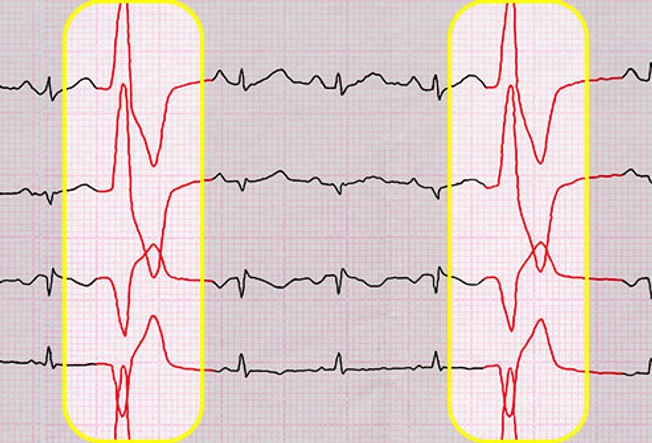Genetically engineered plants are sprouting up to restore the carbon cycle and prevent the further buildup of carbon dioxide
There is a push to use CRISPR to make agricultural technologies that pull carbon dioxide (CO2) out of the air and store it better in the soil. With the help of CRISPR technology, scientists are making gene edited plant varieties that are better at storing carbon and don’t have the traits of genetically modified organisms (GMOs) that are made with transgenes.
Many research projects have sprung up to enhance biological carbon sequestration and thereby help restore balance to the carbon cycle and prevent further buildup of CO2 in the atmosphere. For example, carbon sequestration research is being conducted at the Innovative Genomics Institute (IGI), an organization founded by Nobel laureate Jennifer A. Doudna, PhD. In June 2022, the Chan Zuckerberg Initiative gave $11 million to the IGI to help scientists find ways to protect or heal the ecosystem from harm caused by humans.
Next-generation agriculture

IGI
Bradley Ringeisen, PhD, executive director at the IGI, argues that we must change the way we do agriculture. “We’ve got to feed 2 to 3 billion more people in the next 30 years,” Ringeisen points out. “We can’t keep doing it with the carbon footprint that agriculture has right now. We’re talking about generations, and we have to do this for the planet. And there’s a lot of opportunity in agriculture for carbon capture. Since the start of modern agriculture 125 years ago, the soil has lost hundreds of gigatons of carbon. But crops can be used to help add carbon back into the soil via engineered plants.”
The IGI has started with rice as the model organism. “If we succeed in rice, there are going to be homologues in other grass varieties,” Ringeisen predicts. “Simultaneously, we’re working to try to improve the genetic tractability of sorghum, a really deep-rooted crop that can be used for carbon capture and grain for livestock feed. It’s also a bioenergy crop, so you can imagine converting some of the above-ground biomass into bio-oils or other forms of bioenergy as well. We really see this potentially blooming out into a lot of different areas to really have global impact.”
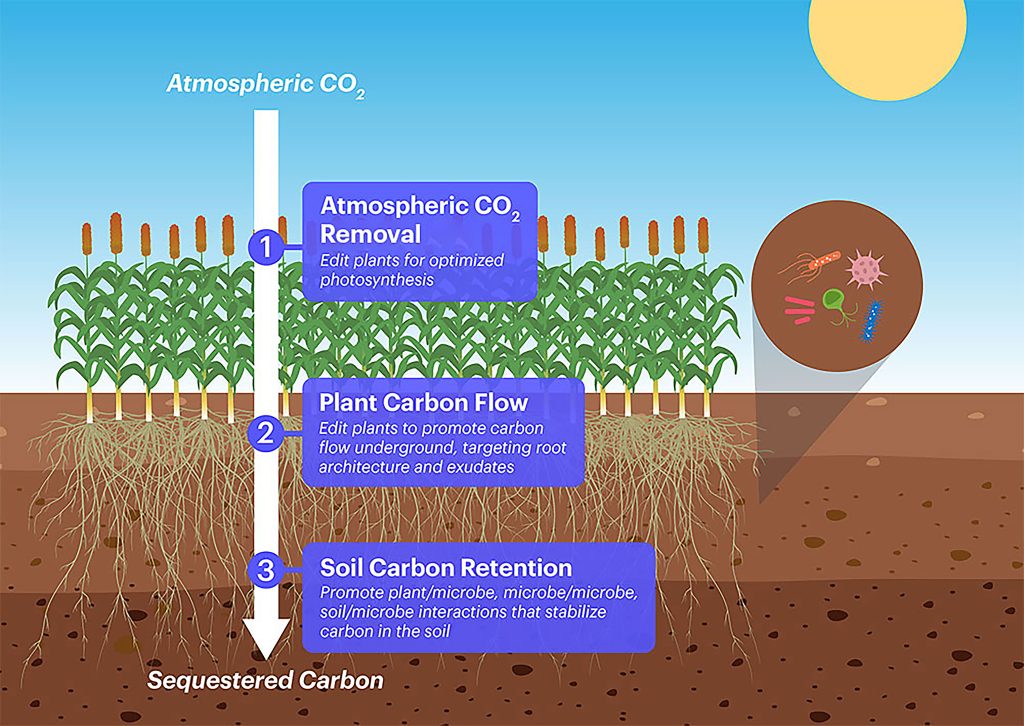
Championing carbon flow
The IGI has designed a program that looks at every single possible touchpoint along the carbon cycle in agriculture. “Right now, farmers and genetic engineers aren’t thinking about this holistically as a carbon cycle,” Ringeisen observes. “How do we increase yield? How do we protect rice from a specific pathogen? People are taking little bites, but they’re not looking holistically at the entire process. The IGI is trying to look at essentially every single step.”
Photosynthesis
The first step is to use genetic engineering or CRISPR to change the process of photosynthesis. Ringeisen says that if you’re going to do carbon capture with biology focused on agriculture, photosynthesis is the way to go because of the increased crop yields and biomass above and below ground. “We’re counting on enhancing photosynthesis so that if we partition off a greater extent of things going down into the roots or going down deeper into the soil, we aren’t going to be reducing the yields,” Ringeisen explains. “If anything, we hope to increase the yields, but that all starts with photosynthesis.”
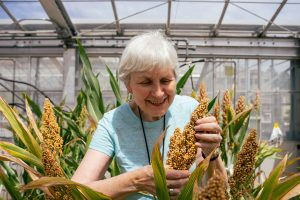
The IGI team is looking into a number of photosynthetic genes that can be put into groups based on how they respond to light and darkness. Krishna K. Niyogi, PhD, a professor of plant and microbial biology at UC Berkeley and an investigator for the Howard Hughes Medical Institute (HHMI), has found a number of genes that could be used to improve photosynthesis. He is known for his work on stopping the mechanism that shuts down photosynthesis to keep light reactions going longer.
But attempts to use CRISPR to genetically engineer plants haven’t succeeded. David Savage, PhD, an HHMI investigator and associate professor of molecular and cell biology at UC Berkeley, told GEN that plants are difficult to target with the CRISPR-Cas9 system because they are highly evolutionarily divergent in ploidy and difficult to culture in tissue form. For example, as Savage notes, CRISPR-Cas9 makes it possible to make “knock out” mice in just a few months, whereas the corresponding experiment on plants would take years.
Savage wants to enhance plant delivery and create extremely effective editors. To do so, Savage has devised a high-throughput screening platform that gets down to protoplasts—plant cells without cell walls that are totipotent, sensitive, and versatile. With this screening platform, there is no need to wait through entire plant life cycles, from seedlings to adult plants, to be able to ask whether a genetic modification–based approach worked or whether a gene was a good target. Savage believes that the platform approach could improve photosynthesis by 30 to 50%.

Root depth
All of this sequestered carbon has to go somewhere, and that’s what the second step is about: plant carbon flow. The additional sequestered carbon that doesn’t go into the above-ground crop yield mostly goes into the below-ground biomass, into the roots, and out through the root exudates (secretions) to the soil. More than 40% of the root’s dry mass is made up of pure carbon, making root mass an essential attribute.
The IGI is focusing on how to enhance the depth of the roots because the deeper you pump carbon into the ground, the greater the likelihood the carbon will stay in the soil. According to Ringeisen, the first few centimeters of soil are where a lot of the carbon turnover occurs. But if the carbon gets into the roots below that till layer, then there’s a much higher probability of the carbon staying there for longer periods of time.
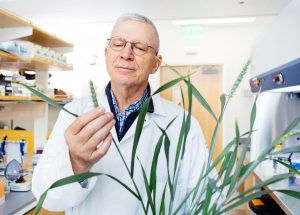
IGI
Brian Staskawicz, PhD, director of sustainable agriculture at the IGI, is partnering with Pamela Ronald, PhD, distinguished professor of plant pathology at UC Davis, to create rice and grass roots that are deeper—at least 30 or 40% deeper than what they are with high-yield varieties. Ronald created a library of thousands of rice mutants by effectively knocking out every gene, which Ringeisen believes will turn out to be a gold mine of information. Ringeisen says that this research initiative has already identified a few variants that are showing a lot of promise.
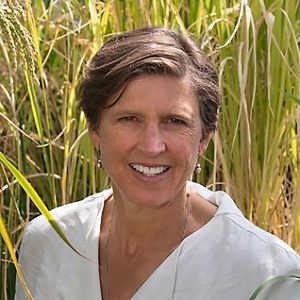
UC Davis
“[Ronald] has found a couple of different genes and ways to affect root depth, but that is the tip of the iceberg,” Ringeisen stresses. “If she focuses on root architectures in that library, there will be a huge amount of discovery. We will focus early on these mechanisms that she has already found. There will be a lot of potential discovery in that mutant library from her moving forward.” The goal is to work with those variants and identify other genes and processes to extend the roots even deeper to conduct field trials.
Soil microbiome
The third step deals with capturing the carbon that leaves the roots to look at how the carbon flow into the soil works. “We’re trying to understand what kinds of keystone mechanisms are at play between the rice, its secretions, and the rice microbiome,” Ringeisen says. “How do we engineer that system? Is there a role for CRISPR in engineering the plant? Is there a role for CRISPR to potentially directly engineer the microbes? Or is it potentially just how you feed the microbiome and how you sort of farm the microbiome to promote the organisms that you want?”
Jillian Banfield, PhD, a soil microbiologist at UC Berkeley who famously introduced Doudna to CRISPR in 2005, is trying to reconstruct the genomes of the organisms that are actively taking out the carbon that the plant is making. Her team’s study of the rice paddy microbiome is probably its most in-depth work, and Banfield will use it to look into ways to reduce soil emissions. “If you can reduce the emissions, that means you are probably shutting down the escape of greenhouse gases and maybe building up more carbon in the soil as well,” Ringeisen suggests.

Lawrence Livermore
Jennifer Pett-Ridge, PhD, a staff scientist at Lawrence Livermore National Laboratory, works with Banfield. Pett-Ridge is in charge of tracking the organisms of microbial communities and determining how they may stay in the soil for longer periods of time. Her story is one of sticky molecules that help the carbon adhere to the inorganic and mineral deposits in the soil. She thinks that the trophic interactions in the rhizosphere, the underground zone within the influence of the roots, are what create the precursor for some of the carbon to be absorbed onto mineral surfaces and caught up in little aggregates. She also studies processes involving extracellular polysaccharides and extracellular polymeric substances, which tend to be enriched in soils where carbon is increasing.
Pett-Ridge’s plan for the project supported by the Chan Zuckerberg Initiative is to focus on crops harvestable for food or fodder. She says that we have control over crops in a way that we do not have control over wildland plants. She hopes to develop crops that will have deeper roots, interact with more extracellular polymeric substances, and (perhaps someday) develop enhanced partnerships with the different populations living in their rhizosphere. All those traits take advantage of what we naturally know leads to more carbon accrual.
The IGI is working from all angles, framing solutions in a way that’s acceptable to the richer farmers in the United States but also to farmers around the world. “We’re hoping that the IGI can be the hub to help advance technologies that promote a net-zero farm,” Ringeisen declares. “This is the future.”




.png)













